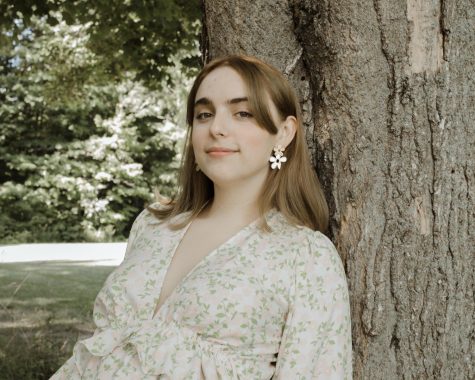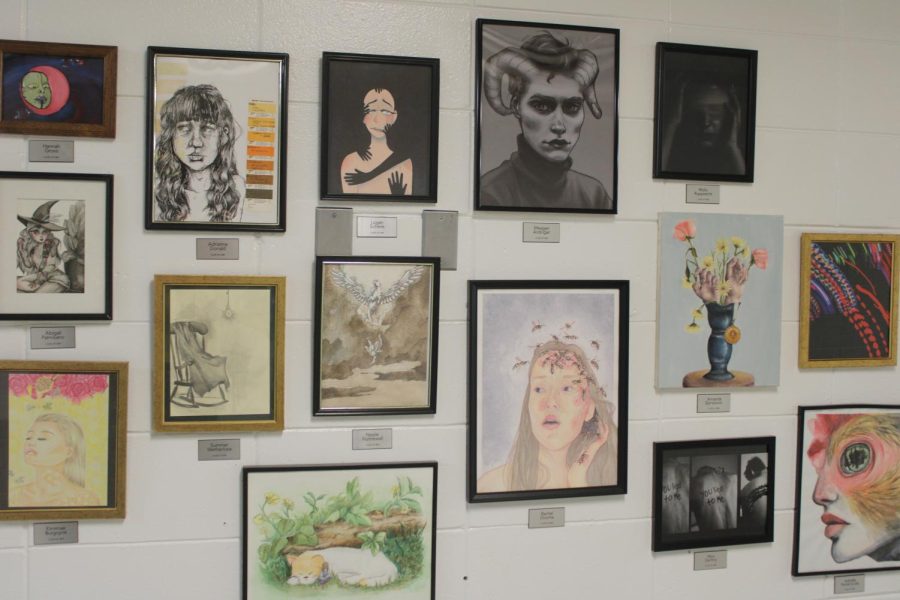With a touch of creation and a tinge of vibrancy, AP Art serves as a hub for ingenuity and togetherness
The collection of projects that greets students and staff as they enter the Art Department.
For as long as they can remember, junior Michael Boughton has been encircled in beauty.
Michael can recollect their mother urging them, from an early age, to love themselves and the world around them. It’s not only this advice but her unending support that pushed them to apply to Goodwillie Environmental School, a habitat in which they were able to fully realize the underlying artistry of life. From the halls of their 5th-6th grade academy, they’ve flourished back into the FHC environment where they have been successfully finding pockets of the beauty that they need to thrive.
It’s this same longstanding idea that serves as the inspiration for Michael’s sustained investigation in AP Art—a course that they are experimenting with for the first time this semester.
“I wanted to [take AP Art] because my theme [is] beauty and how I try to achieve it,” Michael said. “I feel like using a bunch of different mediums and combining that into a piece is a really important part of that because a lot of things are beautiful.”
Nestled deep within the Art Department, Michael and their fellow AP artists are finding their own ways to delve into their imaginations. From two-dimensional projects to sculptural masterpieces and creative snapshots, this hour serves as a time for students to work on their sustained investigations—a faction of the AP Art and Design portfolio scored on many different factors including inquiry, practice, ideas, and more.
Yet, while portfolios and investigations serve as the crux of the class, they are not most often why students find themselves in the course. Being able to relax within a creative space is a virtue provided by AP Art, the structure being looser and more geared towards pupil participation and ingenuity.
“You can just have a chill day [in art] and section out your own time to figure out when you want to do things,” Michael said. “We always do “Weird Wednesday” where we do something fun for five minutes, and [today] we made pumpkins. It’s just a really nice break in between your day.”
Michael speaks for other AP Art students when they say that having an hour each day to zone out, create, and surround yourself with kindred minds is truly a necessity. Within this tranquil environment, Michael has managed to find a group of people just as fascinated with beauty as they are, and their peer’s differing perspectives and notions on these concepts are what provide them with the most peace of mind.
“I think art is really important because it lets us express ourselves, and I use it a lot for self-reflection or therapy,” Michael said. “It can be a way to get your emotions out and a way to convey something that you can’t necessarily convey with words.”
For senior Kevin McPoland, art takes a different yet complementary form. Trekking through the last four years with a camera in tow, Kevin found his way into the art department, and it’s a home away from home that he is not looking forward to saying goodbye to.
Similar to Michael, AP Art serves Kevin not only with a graduation credit or a community, but with an opportunity to lose himself in the lens. Each day, he is able to focus on projects that personally intrigue him, a pursuit that has made way for the exploration of his relationships and community.
“Last year, my sustained investigation was [on the] effects of bipolar [disorder]. I chose this because of how relevant it was in my life, and tried to turn something so negative into something that had beauty behind my art,” Kevin said. “As for this year, my sustained investigation is mostly suburban photography along with the overarching question of why does art have to have ‘a why?'”
Within this webbed world of snapshots, Kevin finds a strengthening comfort and security. Seeing people relate to and fall in love with his creations only bolsters the bond between him and his camera.
Not only that, but the art department and its inhabitants reinforce his desire to traverse its halls whenever the opportunity arises.
“Luckily, I have two hours of my day down in the art department, and truly it makes school enjoyable,” said Kevin, who finds solace in snapping photos of his friends and fellow classmates. “It gives my brain a break and lets me work on what I’m truly passionate [about].”
Finally—within the part of the art department set aside for more tactile pursuits—junior Sofie Brown has found herself exploring the worlds of sculpture and ceramics. Fittingly, she has sparked a focus on the connections humans form through their hands, a passion she is shimmering the spotlight onto for her sustained investigation this semester.
From the throws of a course she did not want to be in, to diving deep in the calming waters of AP Art, Sofie stresses that the study of creativity serves as a versatile and robust channel for her emotions, even though she, in her own words, “absolutely cannot draw.”
“I was in AP Macro because for some reason AP Art wasn’t in my schedule,” Sofie said. “I switched, and it is an hour where I can set everything aside. I don’t have to think about school, and I can just focus on something that’s so calming. It’s an outlet [for] me.”
Within this outlet, Sofie has also begun to consider how her passions may tie together. As an individual who has always been passionate about medicine and the arts, she finds equal consolation in her many interests. However, by studying human hands and working with clay every day, she is narrowing down the career options that may rest in her bright future.
“I’ve always had a passion for art, but I’ve always wanted to go into medicine, and I think some principles of science and art are similar,” Sofie said. “We’re always trying to find and experience new things. But I’ve honestly been thinking about becoming an art therapist. I think that kind of combines both my passions.”
Each and every student who finds themselves in AP Art has their own devotions to pursue and their own stories to tell, an attribute that shines through in the design of the course. By deciding what they’d like to focus on, the art department’s bright and eager minds are slowly shifting the community at FHC to an attitude of creativity and togetherness.
“I think everyone should take at least one art class because it’s such a great creative outlet and we have so many resources here that you might not have when you’re older,” Sofie said. “I would just encourage everyone to try it because you never know if it’ll be one of your passions.”

Jessie Warren is a senior, and this will be her second and final year as a staff member of The Central Trend. Ever eager to write, she finds a sort of...

























































































